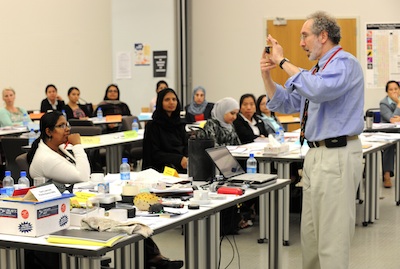WCMC-Q Shares Safety Training with Qatari Science Educators
March,2011

James Kaufman, Ph.D., discusses laboratory safety with science
educators from Qatar at the WCMC-Q sponsored safety training program.
Safety in science laboratories, whether in industry or in education, is not accidental. It is the result of attention to detail and a commitment to policies and procedures that promote safe standards by everyone in an organization.
James Kaufman, a former college chemistry professor who is founder and president of the Laboratory Safety Institute, shared strategies and techniques for developing effective laboratory safety programs with secondary school science educators in Qatar at a day-long workshop Wednesday.
The workshop, which was sponsored by Weill Cornell Medical College in Qatar, provided more than 90 teachers, technicians and administrators with specific training in lab safety measures and with resources to share with colleagues.
“In the United States, the accident frequency in schools and colleges is 10 to 50 times greater than in the chemical industry,” said Kaufman who worked early in his career as a research chemist with the Dow Chemical Company, where he became increasingly involved in laboratory safety related activities.
“The single most important component of a safety program is an orientation on health, safety, and environmental affairs orientation for all new employees and students,” Kauffman told the teachers. “Awareness that working safely is a condition of employment or participation in the school is an essential part of building a culture of safety,” he said. Topics discussed during the workshop included eye and face protection, proper storage and handling of chemicals, and hazardous waste disposal.
Kaufman told the educators that anyone conducting experiments with hazards or potential hazards should ask themselves the following questions:
• What are the hazards?
• What are the worst possible things that could go wrong?
• How will I deal with them?
• What are the prudent practices, protective facilities and equipment necessary to minimize the risk of exposure to the hazards?
Kaufman provided the teachers with a 270-page manual containing an extensive list of materials that documented practical steps for laboratory safety, including a pamphlet he developed, “Laboratory Safety Guidelines,” that listed 40 suggestions for a safer lab, which could be implemented with minimal or moderate expense.
Some of the discussion centered on simple suggestions. “The worst time to test a fire distinguisher is when you need it,” Kaufman told the teachers. “It’s a good idea to test a fire distinguisher before you need it, to make sure you know how it works, how it sounds, and how effective it is,” he said.
A more comprehensive two-day version of the workshop was also provided to health safety security environment (HSSE) professionals, researchers, and administrators in Qatar.
The workshops were organized by Thomas Doyle, director of environmental health and safety for WCMC-Q. “This training supports WCMC-Q’s commitment to help Qatar build a knowledge-based society,” said Doyle. “My goal is to help promote a culture of safety within WCMC-Q and throughout Education City and the state of Qatar.”
By Kristina Goodnough
